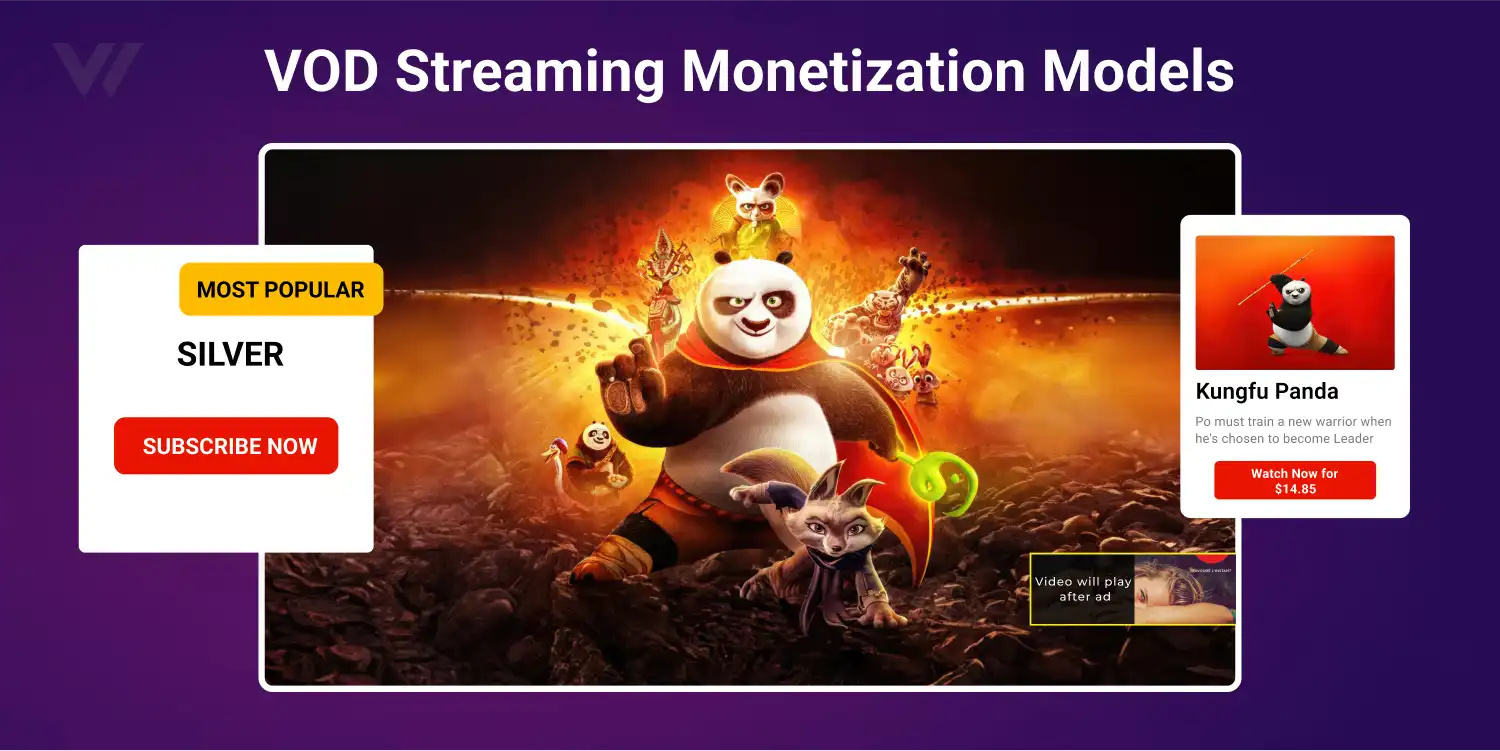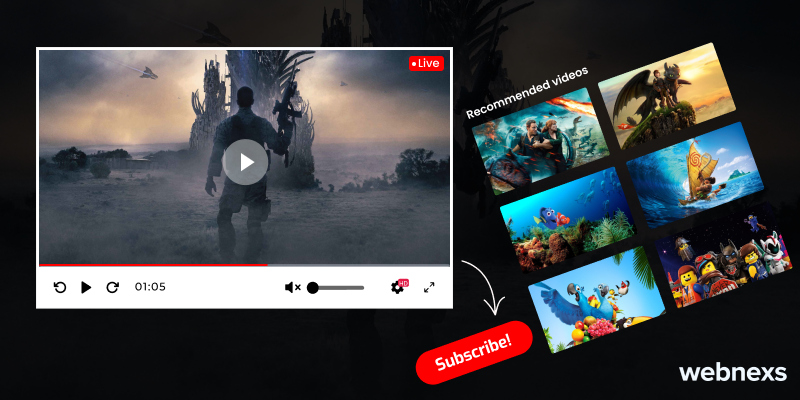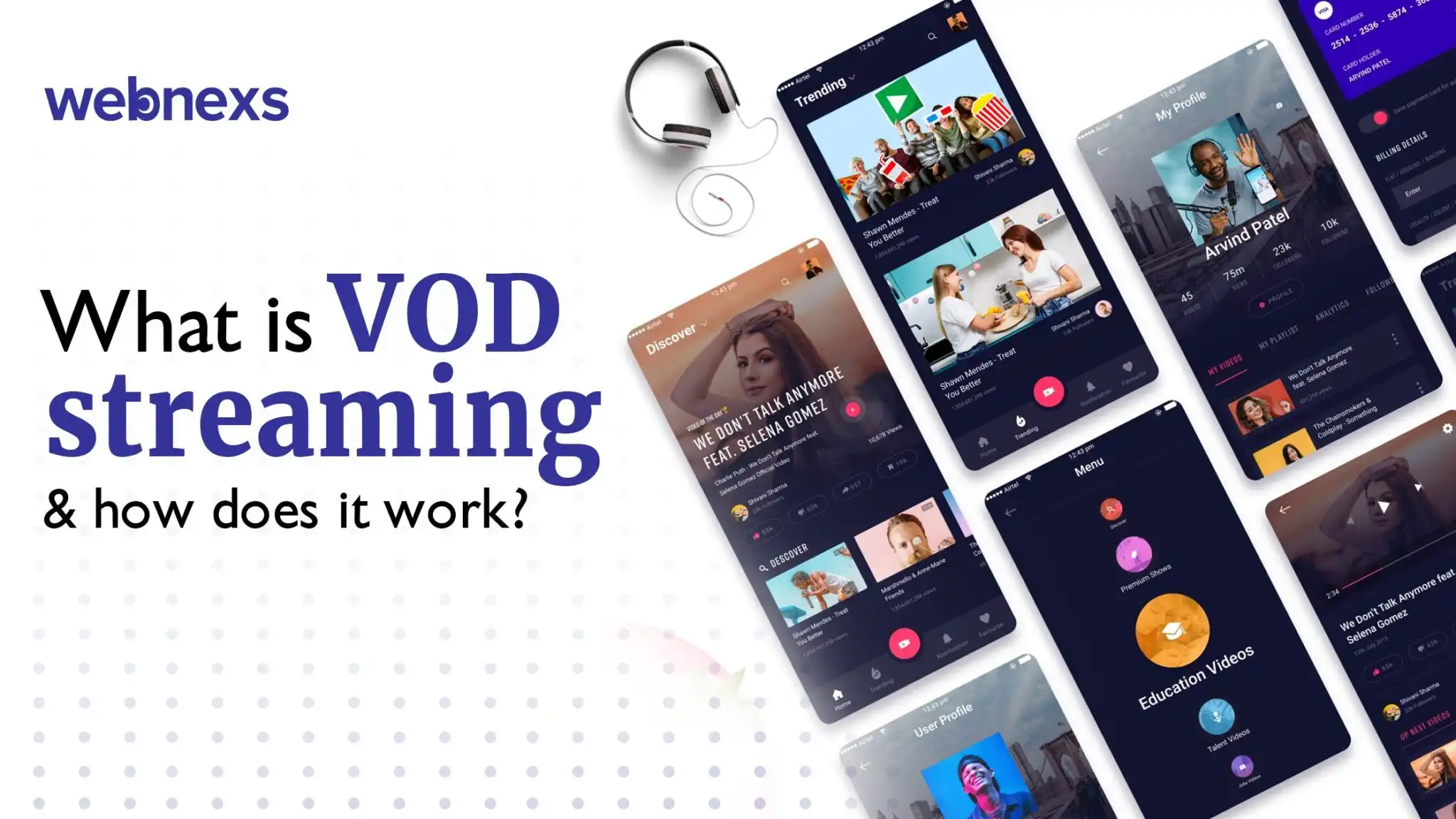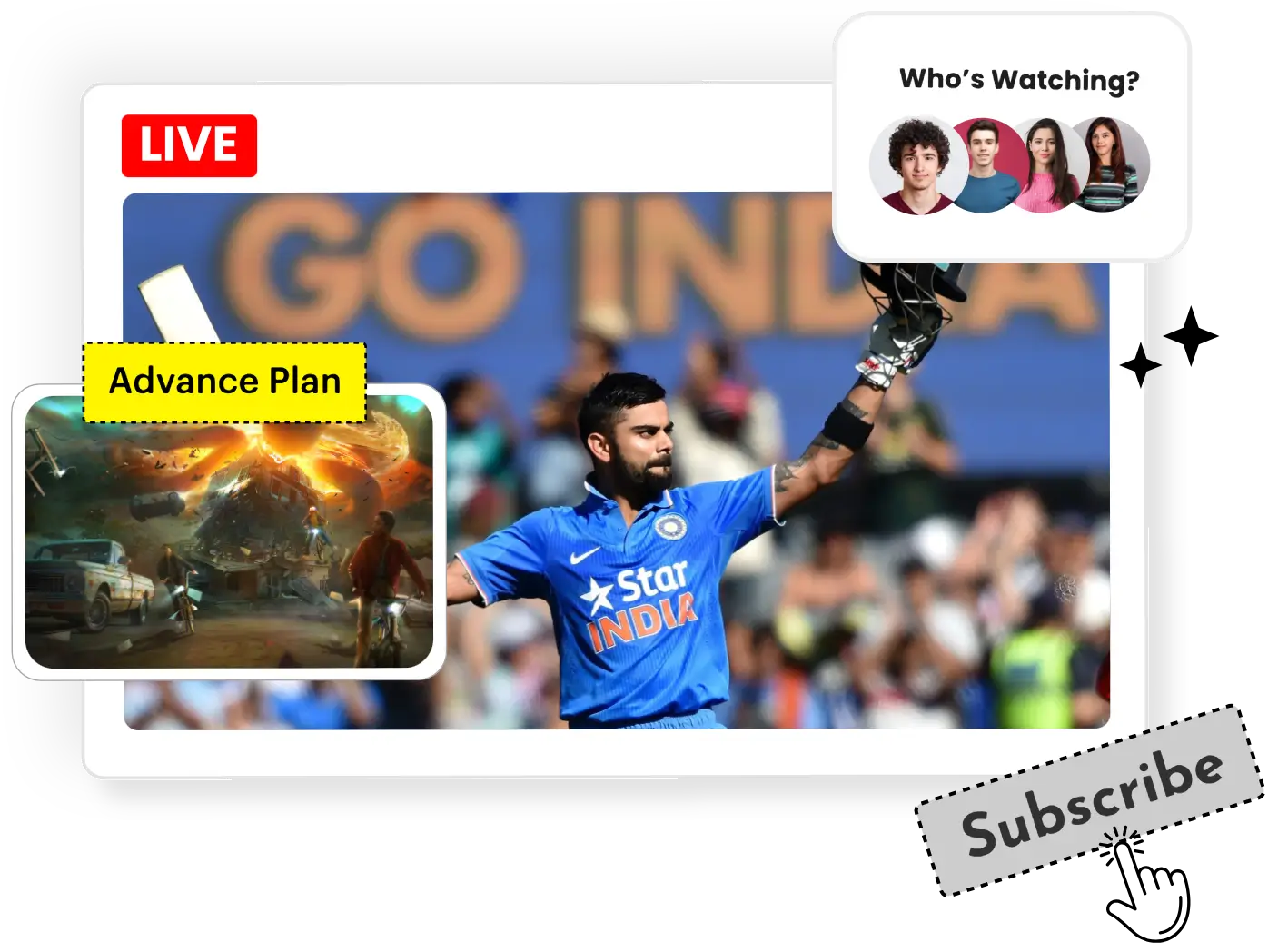Did you know that VOD (Video On Demand) streaming has completely reshaped the way we enjoy content? With the power to watch anything, anytime, anywhere, VOD has quickly become the go-to choice for millions worldwide.
Curious about what is VOD streaming and how it works? It’s a revolutionary service that gives you instant access to a vast library of content, putting the control in your hands.
“According to Global Market Insights, South Africa’s Pay-TV streaming video-on-demand industry is projected to experience an 18% surge in VOD business by 2026”.
If you’re a content creator looking to reach a global audience, now is the perfect time to explore ott VOD platforms. These platforms open up endless possibilities for engaging with viewers, helping you grow your business and brand.
In this guide, we’ll show you the best streaming platforms to help you start and grow your own VOD business. Let’s get started!
Statista projected that, in 2021, an average of $47.86 revenue per user will be generated from VOD services. This number is expected to grow even more in the future, with over 2 billion users forecasted to use these services by 2025.
Key Takeaways:
- Explain VOD meaning, emphasizing its flexibility and how it allows users to access content anytime.
- Explain how VOD streaming services differs from traditional broadcasting, focusing on user control and flexibility.
- Provide examples of common OTT Video on demand services and platforms, showing their widespread use.
- Use keywords naturally to enhance SEO while ensuring the content remains informative and engaging.
- Include emerging trends in ott VOD streaming, such as personalized recommendations and AI-driven content delivery.
What is VOD Streaming?
Vide on demand streaming allows them to watch videos at their convenience and on any device that supports it.
VOD vs OTT – VOD platforms include Netflix, Disney+, and Hulu all popular services also known as OTT Platforms. Official partners of the network provide these services for consumer-oriented entertainment purposes. These sites do not allow independent creators to upload their content.
Videos from independent creators and organizations can be hosted and delivered through video hosting platforms like Webnexs. Such a program facilitates video management, monetization, and delivery. Associated content delivery networks enable these platforms to deliver content online (CDNs). CDNs are a collection of globally dispersed servers that deliver content to businesses and online audiences quickly and reliably.
Professional-grade These platforms give broadcasters complete control over the distribution of their content. White-label and custom branding options are available from the best providers.
VOD Platform Statistics & Trends:
As VOD services become more mainstream, providers are increasing their OTT pricing strategies in order to reach out to a wider audience. In South Africa, according to Global Market Insights, it is predicted that Pay-TV VOD streams will experience an 18% increase in business growth by the year 2026
The rise of VOD (video on demand) has been driven by increasing internet penetration, the global adoption of smartphones, and the growing need for social distancing. The convenience of remote viewing, along with attractive video packages offered by Asia-Pacific markets, has further fueled its growth. Understanding VOD meaning, it refers to a service that allows users to stream or download content at their convenience, making it a popular choice for modern viewers.
It offers an average revenue per user of $47.86 in 2021, and the number of users is predicted to reach 2,218 million by 2025, according to Statista’s projections. With its rapid growth, it continues to be one of the most popular online platform services available.
Difference between Live and VOD Streaming:
For a variety of reasons, Video on demand streaming services differs from live streaming. While video-on-demand libraries consist of previously recorded audio and video content, real-time is the main difference.
You should be aware that choosing one method leads to another for the majority of brands. If you want to repurpose live videos, you can. If you want to create an effective video marketing strategy, you need to plan.
Live Streaming:
The biggest advantage of live streaming is that it allows customers to experience events in real-time. Being a part of a lively online event gives them a sense of belonging. A sense of exclusivity and community is created by live streaming.
Even in the business world, it can be a valuable tool. Brands can reduce costs and improve service by maintaining an active online community They can deliver the same experience online as they would at an in-person event without having to pay for travel, lodging, or meals.
In addition, brands can use live streams for product demos and press releases. Because of this, the audience and employees are kept in the loop about product or service updates.
Live streaming is technically more resource-intensive than VOD (Video on demand). In addition, the number of messages per block is greater than before. This reduces the time between streaming events and the remote players.
Read more: H.265 Codec: How to Choose the Best Compression Standard for VOD & Live Streaming
VOD (Video On Demand)
As opposed to living, ott VOD serves a different purpose. Users can watch content on any internet-connected device at their convenience. This isn’t limited to movies or television shows. A video-on-demand library can include tutorials, educational content, motivational messages, and other forms of entertainment.
VOD’s explosive growth can be attributed to modern, busy lifestyles. You can access the content at any time of day. In addition, Video on demand streaming services allows broadcasters to fine-tune their content strategy before going live.
Videos can be recorded, edited, and improved by the creators before they are released to their audience.
How does OTT Platform Work?
Cable and telecom networks are bypassed by over-the-top platform services, which do not require a subscription. There are usually different subscription rates for each of these OTT providers, and each includes a specific bundle of their products. As a result, the provider decides what content or channels users receive as part of the bundle.
Users should not be forced to pay for services they don’t want. Unless they upgrade to a more expensive package, audiences have no say in what they get.
Other restrictions include a need for a particular type of hardware, as well as access to regionally specific content (such as sports). OTT, on the other hand, is not like that.
Regardless of their location, equipment, or time of day, audiences have access to all authorized content.
As a result, OTT technologies monitor and adjust content delivery metrics in real-time to improve performance while minimizing disruptions.
Service providers can serve multiple streams at the same time thanks to features such as adaptive bitrate streaming. By offering a wide range of bandwidth options and device types, broadcasters can reach more people.
A better segmentation capability is another advantage of using OTT vod. Your users can sign up for the specific information they want to learn about instead of bombarding them with the same content. It will allow them to provide more detailed, actionable advice.
Visit Here: 5 Best Video On Demand Platforms (VOD) In 2022
Want to launch your own VOD streaming service?
What Makes a Great VOD Service?
Many consumer-based and social media video hosting options do not meet the needs of businesses and high-volume broadcasters.
This type of media outlet has poor security controls, limited monetization options, and focuses more on its branding than that of its users’
These broadcasters choose business-grade platforms to grow their brands and provide the best online content experience. Video hosting, live streaming, and Video streaming services are all integrated by partners Webnexs to give organizations and influencers a complete solution.
- Utilize your logos, colors, and images to ensure that your brand is front and center in the Video on demand experience. No ads or interruptions are shown on your content.
- Create your own OTT platform and mobile apps using API and SDK access.
- Permissions and access controls for multiple users within your organization and each audience group can be customized. Protect your content with built-in safeguards to ensure that only the intended audience can view (or share) it.
- Capture events as they happen and automatically save them to your ott VOD streaming library with a live recording. Improve search options and functionality of your CMS by categorizing it with tags and filters.
- Use world-class CDNs and offer multiple viewing options for various devices to provide exceptional user experiences.
Video On Demand(VOD) Streaming Monetization Models:

They want to monetize their content at another level of complexity, which is why they create VOD platforms.
Paid streaming services like Hulu, Netflix, and Disney+ are among the most popular.
1. Advertising Video On Demand (AVOD)
If you’re using AVOD, you’ll have access to content for free, but you’ll have to put up with sponsored ads.
YouTube is a good example. Without the need for subscriptions, AVOD lets broadcasters monetize their content without the need for paywalls.
2. Subscription Video on Demand (SVOD)
It is SVOD that most viewers are familiar with. In exchange for a recurring monthly fee, users have access to content. Consider Netflix or ESPN+.
3. Transactional Video on Demand (TVOD)
The third option, TVOD, is the least popular. To stream and access specific content that isn’t available anywhere else, TVOD users must pay a subscription fee to access it. When HBO charges extra for an online boxing match or concert, that’s TVOD in action.
Click here to see the video on demand solutions
Ready to monetize your video content with VOD?
Benefits Of Using VOD Streaming

Convenient
Video streaming services helps users to watch the content anytime and anywhere without any fixed schedule. Viewers can skip, forward or pause the content based on their convenience.
Interesting fact: Over 85% of the consumers prefer the on demand content as compared to traditional tv content, because they can watch they want and when they want without any fixed schedule.
Wide Variety of Content
Video streaming platform provides a variety of content which includes movies, TV shows, educational videos etc in different languages which meet the taste and preferences of the viewer.
Interesting fact: Streaming services like Netflix and Amazon Prime offer access to about 100,000 hours of video content, including everything from original series and documentaries to movies and international shows.
Accessible
Whether it is on smartphones, tablets, smart TVs and computers, content presented in vod can be accessed at anytime at their convenience which makes the viewer watch it anytime.
Interesting fact: According to a report, 95% of U.S. households have access to at least one Video streaming platform, showing how widespread and accessible these services have become, even in remote areas.
Personalized Watching Experience
Tracks the viewer’s preferences, watch history, or ratings and recommends the content based on it. It helps the viewer to find new content on the platform.
Interesting fact: 80% of Netflix viewers are influenced by the platform’s recommendation algorithm, which customizes content suggestions based on their watch history and preferences, creating a tailored viewing experience.
Ad-free Experience
Most of the video streaming platforms provide ad-free experiences based on some subscription, which helps the viewer to watch the content without any interruption.
Interesting fact: On average, 56% of VOD users say they prefer ad-free streaming experiences, which is why platforms like Netflix and Hulu’s premium subscription services are seeing a rise in demand for their commercial-free options.
How Can You Choose the Right Streaming Services for Your Business?
Choosing the right platform for your VOD business needs can be a challenging task. In order to get the most out of VOD, you need to take into consideration three key factors. These include selecting services that offer high-quality, scalability features, and reliable support services. By prioritizing these criteria, you’ll be sure to find the perfect platform for your business.
Privacy & Security
It is one of the biggest priorities for businesses when it comes to selecting an Enterprise Video Platform. To ensure data and information being handled remain secure, the EVP should offer enterprise-grade encryption, DRM, fine-grained access controls, and Single Sign-On authentication. By using these features, businesses can limit unauthorized access and downloads of sensitive information stored on the platform.
Reliability
Video on Demand is an online service that allows businesses to stream videos whenever and wherever their audience needs them. To guarantee reliability, make sure you choose a provider that offers effective Content Delivery Networks (CDNs) and Adaptive Bitrate Streaming (ABS). With these tools, you can be sure that your business’s videos are accessible everywhere and anytime.
Flexibility
For businesses, it provides an invaluable way to optimize the course of entities’ development. What’s more, with seamless customization capabilities, VOD platforms can cater to the company’s distinct needs and help create a powerful brand experience for users.
Why VOD Streaming Is Essential For Your Business
Boost Engagement
VOD streaming services naturally engages audiences, as compared to text or images. Businesses can stream their events, Q&A sessions, product launches, chats to connect with their audience in real time.
Cost-effective
Video streaming services are the cost-effective way for the business to reach their audience as compared to physical or traditional methods of marketing. With the help of various tools and features, businesses can develop high quality videos within their budget.
Improve Your Sales
By utilizing VOD services for their events, it helps businesses to reach a wider audience, and connects with audiences in real-time which can ultimately increase sales for the business.
Provides Real-time Analytics
VOD services will provide real-time analytics for the businesses. With metrics such as watch time and audience engagement, businesses can gain valuable insights based on the audience preferences and needs, based on the needs the business can personalize the marketing strategies and attract the audience to drive sales.
Build Trust
Businesses use VOD platforms to provide real time access for their audience in events and Q&A sessions so that it builds transparency and trust among people, which in turn leads to higher conversion rates.
Get Started Your VOD platform With Webnexs
Are you looking for the best Video streaming platforms for your business? Webnexs is a great option for modern video services. It provides features like personalized viewing experience and monetization, enabling you to offer high-quality content and maximize revenue from your videos.
There are a lot of advantages to using the Webnexs VOD platform and associated OTT apps. With features like top-rated ratings and an enticing selection, Webnexs stands out among other options. So why go for Webnexs? Here are some of its standout benefits!
White Label Platform
Webnexs allow Platform owners to get the website domain, technical features, and much more for a smooth user experience.
Subscription VOD
It offers variable plans to your users. You can sketch your own plans, charge monthly, quarterly, or annually, and even offer free trials to your subscribers
Advertising VOD
Monetize your video platforms with ad supports like pre-rolls, mid-rolls, post-rolls, and third-party video Ad servers like SpotXchange, Doubleclick & more.
Pay-Per-View PPV
PPV or Transactional VOD support lets you charge every time a viewer watches a piece of your content. Sell your videos or limit the access through the number of views for any particular content.
Coupons and Promotions
Get your audience with coupons for any specific series, movies, or events via your live video sharing platform. Make one-time coupons, discounts for the subscription fee, and more.
Using Video Encryption
Webnexs uses the video encryption method that permits the content owners to encrypt videos & audio using 128-bit cryptographic keys. Users having a similar key have access to the content
Third-Party Ad Integration
Combine with third-party ad managers to push ads to your platform and enable show tracking to monetize your audio & video platforms.
Privacy Setting
This permits users to simply choose their friends and social media platforms for expressing their choices. Users can choose as various people from any specified area or time.
Analytics & Reporting
You can analyze and track the completion of each video and audio content at the minute level and know your user’s behavior on the platform.
Low Latency
Eliminate buffering of videos online. Webnexs ensures of quality content over OTT, Live streaming & Video streaming without any delay and ignoring network bandwidth.
Conclusion:
With changing consumer tastes and preferences, the demand for convenience and value remains an ever-present force. This is why video-on-demand (VOD) services remain especially popular and successful due to their ability to continuously meet these needs.




28 Responses
In the recent days, I was struggling to find what is VOD Streaming and How it Works with OTT and this article helps me a lot out of it…thanks for sharing
I’ve been trying to locate what is VOD Streaming and How it Works with OTT the for my business in recent days, and your article has been quite helpful….Good job!!
I am trying to find what is VOD Streaming and How it Works with OTT for my business and you have shared the solutions your article helped me out of….
For the past few days I’ve been slightly confused about what is VOD Streaming and How it Works with OTT and by this post, you resolved all my issues….
Thanks to this article, Now I can choose the what is VOD Streaming and How it Works with OTT for my business
Hello Webnexs,
This is such a wonderful article. I got learn more about VOD Screaming. Thanks for this piece
Love,
Stephen
Hi there, I’m interested in finding out more about video on demand meaning. I’d like to know if you offer customized options. Also, what cost do you available? Thanks for your help!
It is essential to understand VOD meaning and its implications. This will help ensure that readers are better informed and can make more informed decisions when it comes to utilizing these services.
Hello there! I am looking for information regarding video-on-demand streaming. Can you provide me with more details on what vod streaming entails? Also, are there any options available for unlimited bandwidth and video streaming storage? Could you please share me the demo & pricing?
Informative blog about the current trends, it is important to be aware of what video on demand streaming is and its meaning. It’s a great time to learn more about this subject matter!
Knowing the new trends can be beneficial and helpful. One such trend is video-on-demand streaming. It’s important to understand what is VOD Streaming and how it works in order to make the most of this technology.
Such a wonderful article on VOD Streaming. Can I know if you guys provide this service. I have a related startup idea. Would love to get in touch with your team. Can you share me the contact of the respective team.
Please contact:- sales@webnexs.co
Thanks for providing the interesting articles, they are great to read. I am currently researching what streaming VOD is and how it can be used for video solutions, so I will bookmark this post for future reference.
Recently read through the blog post on Webnexs about VOD streaming and streaming services, app & definitions. please share the pricing?
Could you provide some additional details about your specific video on demand VOD streaming needs? We would be happy to provide a quote once we have a better understanding of what you require.
Please contact:- sales@webnexs.co
This article will be very beneficial for video business owners who are looking to choose the best VOD streaming solution that meets their specific requirements.
I really enjoyed reading about vod meaning. I’m currently working on creating a video on demand streaming website and app, and would benefit greatly from any advice or tips you could provide with regard to this project.
This is a comprehensive and informative article about Video on Demand (VOD) streaming. It’s an invaluable resource for video business owners who need to choose the right streaming solution provider that meets their specific needs and requirements. Excellent job!
I enjoyed this Blog! Is this a custom-built video streaming solution or an existing white label product? Demo available?
I am inquiring about the pricing and availability of a scalable VOD (video on demand) streaming platform. I am also interested in getting a demo of the product to understand its features better. Thank you for your help.
Please contact:- sales@webnexs.co
Good day, I am interested in viewing a demo of your VOD (video on demand) streaming platform. Additionally, I would like to inquire about the customization features and pricing?.
Please contact:- sales@webnexs.co
VOD is a game-changer in live streaming, this blog is very descriptive. Great article.
The quality and selection of VOD platforms are fantastic. So glad I switched. Thank you for the blog.
Your services offer so much variety! May I know how the VOD Monetization works?